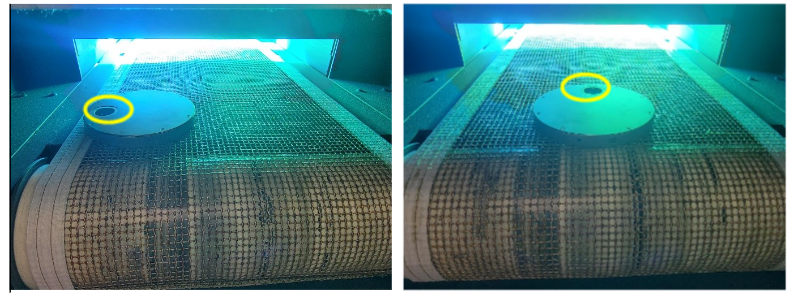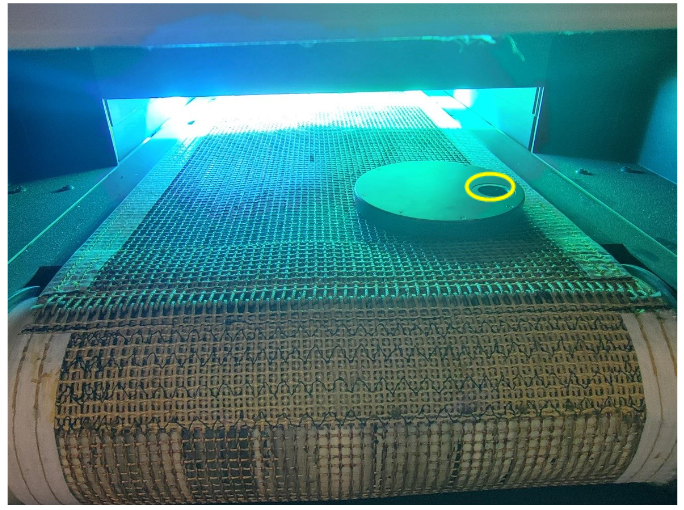
We recently published a blog outlining radiometer configuration and usage. Give it a read if you missed it! Since you’re now an expert at operating your radiometer, this blog will look at the steps needed to optimize your UV or LED oven.
This process is practically as simple as increasing and decreasing the UV or LED cure system’s conveyor speed to affect the dose. You must also consider increasing and decreasing the distance between the cure system’s lights and the radiometer to achieve at least the minimum irradiance required per the coating, adhesive or GELS technical data sheet.
One further note regarding LED cure systems is to ensure you’re using a light source that not only has the correct power (Watts), but also emits UV energy in the correct wavelength.
How to Calibrate a UV or LED Curing Oven
- Grab the Technical Data Sheet (TDS) for the HumiSeal UV or LED coating, adhesive, or GEL that you’re going to be processing and go to the curing section of the document.
- Note which type of UV or LED system you have. For full UV curing systems, you will either have a microwave or arc-style UV system. For LED curing systems, be sure to match the wavelength and power requirements.
- Using the steps above, turn on and pass your radiometer through your UV or LED cure system.
- Compare the radiometer data with the requirements noted in the coating, adhesive, or GELS technical data sheet.
Tips for Calibrating Microwave Curing Ovens
For microwave or arc systems, the relevant data is in the UVA, UVB, and UVC bands and it is especially important to meet at least the minimum values recommended on the technical data sheet.- Dose in UVA and UVB typically provides for the through cure of the coating, while irradiance in the UVC band provides for the surface cure of the coating, adhesive or GEL.
- If the dose in UVA and UVB are below the recommended minimum requirements, slow down your conveyor speed. This will increase the time under the UV light which in turn will increase the dose received.
- If the irradiance in UVC is below the recommended minimum requirements, that usually indicates the Z-height distance between the radiometer and UV light is too far and should therefore be decreased. Shortening the Z-height distance between the radiometer and UV light will increase the UVC irradiance which in turn will ensure the surface of the coating, adhesive or GEL is rendered tack free after leaving the UV tunnel and returning to room temperature.

Tips for Calibrating LED Curing Ovens
For LED cure systems, you will be measuring a single wavelength (ex. 395nm); so be sure the LED radiometer you are using matches the system you have. EIT’s 4-band LEDCure radiometer is capable of measuring 4 distinct wavelengths (365nm, 385nm, 395nm and 405nm). However, other commercially available LED radiometers will typically be calibrated to measure a single wavelength.- In the same manner as described above, increase/decrease your conveyor speed to affect the dose received to meet at least the minimum requirements noted on the product technical data sheet.
- In the same manner as described above, increase/decrease the Z-height of the LED lights to realize at least the minimum required irradiance value as noted on the product’s technical data sheet.
Using a Radiometer for Routine Oven Monitoring
Monitoring your UV or LED cure oven is critically important in ensuring it operates at peak performance and provides peace of mind knowing the HumiSeal coating, adhesive, or GEL will receive the desired UV energy. This in turn will yield maximum performance. Monitoring your UV or LED source is very simple and requires only minutes of your time. Simply follow the steps below:
- All you need to do is run your radiometer through your UV or LED cure system 3 times. Be sure to run your UV or LED cure oven at normal processing speeds and do the following:
- Position the radiometer and optical window to the far-left lateral edge of your conveyor.
- Note the values.
- Position the radiometer and optical window to the center of your conveyor.
- Note the values.
- Position the radiometer and optical window to the far-right lateral edge of your conveyor.
- Note the values.
- Position the radiometer and optical window to the far-left lateral edge of your conveyor.
- Compare the recorded values to the minimum required dose and irradiance per the HumiSeal coating, adhesive, or GEL’s technical data sheet. If any of the recorded values are low, this often indicates one or more of the following:
- The reflectors are dirty, or the dichroic coating has worn off.
- Clean the reflectors with IPA and a lint-free cloth.
- The light source has degraded over time and indicates to the operator or technician that it’s time to replace the bulb.
- The reflectors are dirty, or the dichroic coating has worn off.


Optical Window Positioning
Final Thoughts
I hope you’ve found this blog informative and left armed with the information and basic process steps needed to be able to fully utilize your radiometer. When properly matched to your UV or LED cure system, the radiometer is a powerful measurement device that can provide engineers and technicians with a clear understanding of the cure system’s performance. This in turn ensures your HumiSeal coating, adhesive, LED curable conformal coatings, or GEL will exhibit optimal protection on your electronic assemblies as well as help you avoid costly mistakes due to sub-par process-related performance of your UV or LED cure system.
If you have any questions on the above topic, drop a line in the comment section below. HumiSeal Technical Support and Engineering would love the chance to provide you with world-class guidance and support!








